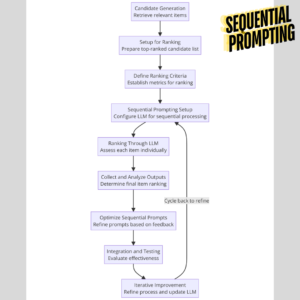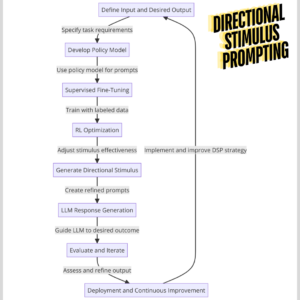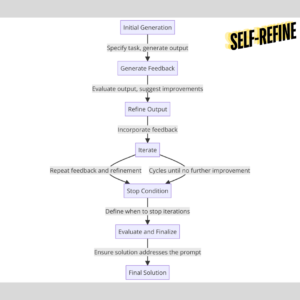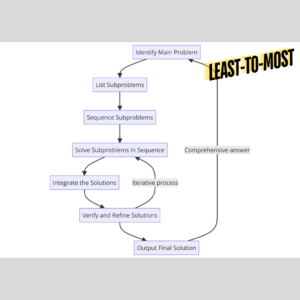When it comes to harnessing the power of generative AI, one crucial aspect often gets overlooked: prompt engineering. This subtle yet critical component can make all the difference in the quality of your AI outputs. In essence, prompt engineering is the art of crafting and optimizing questions or instructions to elicit specific, useful responses from generative AI models. It’s the secret sauce that transforms your AI from a mediocre content generator to a highly effective tool that can revolutionize your content creation process.
So, why is prompt engineering so vital? The answer lies in the understanding that generative AI models often require human guidance to generate meaningful and coherent outputs. Effective prompts are essential for obtaining desired results and minimizing the need for multiple iterations or manual adjustments. The quality of the prompts significantly influences the quality of the outputs, as poor prompts can lead to unhelpful or wrong outputs.
Think of prompt engineering as a delicate dance between humans and AI. You need to understand how to communicate with your AI model in a language it can understand, and how to craft prompts that elicit the desired responses. This is where human-AI interaction comes into play. By understanding how users interact with AI systems, you can design prompts that are more intuitive, more effective, and more likely to produce the desired results.
So, what makes a great prompt? According to experts and experienced prompters, a good prompt should be specific, clear, and concise. It should also be free from biases and assumptions, allowing the AI model to generate outputs that are more accurate and relevant. Additionally, a good prompt should be flexible enough to accommodate different contexts and scenarios, making it more adaptable to various applications.
Here are some tips for crafting effective prompts:
- Keep it simple: Avoid using complex language or jargon that may confuse your AI model.
- Be specific: Clearly define what you want your AI model to generate, and provide relevant context or examples.
- Use natural language: Craft your prompts in a way that feels natural and conversational, as if you were asking a human for help.
- Test and iterate: Refine your prompts through testing and iteration, identifying areas for improvement and adjusting your approach accordingly.
- Use domain specific knowledge: LLMs have been trained on massive amounts of data. There is a great possibility it has been trained on much within your domain expertise. By using domain specific knowledge in your prompts, you will get much more specific outputs.
By following these guidelines and incorporating prompt engineering into your workflow, you can significantly enhance the quality of your AI outputs. This, in turn, can lead to more effective content generation, improved customer support, and even more innovative artistic creations. The possibilities are endless, and it all starts with crafting the right prompts.
The Science of Effective Prompt Design: Understanding the Role of Human-AI Interaction
As we explored in the previous section, prompt engineering is a crucial aspect of harnessing the power of generative AI. However, to truly master the art of prompt engineering, we need to dive deeper into the science behind effective prompt design. This is where understanding the role of human-AI interaction comes into play.
At its core, human-AI interaction is about understanding how humans and AI systems interact with each other. It’s about recognizing the strengths and limitations of both humans and AI, and designing prompts that leverage these strengths to produce optimal outputs. This requires a deep understanding of behavioral economics, consumer psychology, and natural language processing, among other fields.
One key aspect of human-AI interaction is the concept of cognitive bias. As humans, we’re prone to biases and assumptions that can influence our decision-making processes. Similarly, AI systems can be biased by the data they’re trained on, leading to unintended consequences. Effective prompt design must take these biases into account, ensuring that the outputs generated are fair, unbiased, and accurate.
Another crucial aspect of human-AI interaction is the concept of feedback loops. By providing feedback on the outputs generated by the AI model, we can refine the prompts and improve the overall quality of the outputs. This feedback loop is essential for optimizing prompt engineering and achieving the desired results.
Here are some key principles of effective prompt design:
- Know your audience: Understand the target audience and the context in which the AI system will be used.
- Define the task: Clearly define the task or goal the AI system is intended to achieve.
- Use clear and concise language: Craft prompts that are easy to understand, free from ambiguity, and concise.
- Test and iterate: Refine the prompts through testing and iteration, incorporating feedback and iterating on the design. We’ve mentioned this one before, but it is so important it bears repeating.
By incorporating these principles into your prompt design, you can create prompts that are more effective, more efficient, and more likely to produce the desired results. This, in turn, can lead to more accurate content generation, improved customer support, and even more innovative artistic creations.
As we continue to explore the world of generative AI, it’s essential to understand the critical role of human-AI interaction in driving innovation and progress. By mastering the science of effective prompt design, we can unlock the full potential of generative AI and achieve results that were previously unimaginable.
Mastering the Craft: Techniques for Optimizing Prompts and Enhancing AI Outputs

Now that we’ve explored the importance of prompt engineering and the science behind effective prompt design, it’s time to dive into the practical techniques for optimizing prompts and enhancing AI outputs. This is where the rubber meets the road, and we can start to see the real-world impact of prompt engineering on our generative AI outputs.
One of the most critical techniques for optimizing prompts is prompt optimization. This involves refining the prompts through testing and iteration, identifying areas for improvement and adjusting the approach accordingly. By using evaluation metrics such as BLEU scores, ROUGE scores, and METEOR scores, we can quantify the performance of our prompts and identify opportunities for improvement.
Another key technique is fine-tuning, which involves adjusting the hyperparameters of the generative AI model to optimize its performance. This can be done through techniques such as gradient descent and stochastic gradient descent, which allow us to fine-tune the model’s performance and achieve more accurate results.
Regarding prompt optimization, one effective strategy is to use prompt templates. These templates provide a structured framework for crafting prompts, ensuring that they are consistent, clear, and concise. By using prompt templates, we can reduce the complexity of prompt engineering and make it more accessible to a wider range of users.
Here are some additional techniques for optimizing prompts and enhancing AI outputs:
- Use of ambiguity: Intentionally introduce ambiguity into the prompts to encourage the AI model to generate more creative and diverse outputs (I know, we JUST told you not to be ambiguous, but it can be useful in specific, structured experiments).
- Multi-modal inputs: Use multiple inputs or modalities to provide a more comprehensive understanding of the task or goal, and to generate more accurate and relevant outputs.
- Active learning: Engage in active learning, where the AI model is actively involved in the prompt engineering process, providing feedback and refining the prompts in real-time.
By incorporating these techniques into your prompt engineering workflow, you can significantly enhance the performance of your generative AI models and achieve more accurate, more relevant, and more consistent results. This, in turn, can lead to more effective content generation, improved customer support, and greater workflow efficiency.
Beyond the Basics: Advanced Prompt Engineering Strategies for Consistent Results
As we’ve explored the fundamentals of prompt engineering, it’s time to take it to the next level. In this section, we’ll dive into advanced prompt engineering strategies for consistent results. These strategies are designed to help you optimize your prompts, and achieve more accurate, more relevant, and more consistent outputs.
One key strategy is ensemble methods, which involve combining the outputs of multiple generative AI models to generate more accurate and diverse results (we do this regularly with GPT4, Claude3, and Gemini 1.5). This can be particularly effective in scenarios where a single model may not be able to capture the full complexity of the task or goal. By combining the strengths of multiple models, you can create a more robust and reliable prompt engineered workflow.
Adversarial training (or adversarial prompting) is another advanced prompt engineering strategy that helps to stress test and find vulnerabilities within the LLM you are working with. These include methods such as prompt injection, prompt leaking, and jailbreaking.
Here are some additional advanced prompt engineering strategies for consistent results:
- Multi-task learning: Train your generative AI models on multiple tasks or goals simultaneously, allowing them to develop a more comprehensive understanding of the context and generate more accurate and relevant outputs.
- Domain adaptation: Adapt your generative AI models to specific domains or contexts, allowing them to generate more accurate and relevant outputs in those scenarios.
- Few-shot learning: Train your generative AI models on a limited number of examples or inputs, allowing them to generate more accurate and relevant outputs with minimal data.
By incorporating these advanced prompt engineering strategies into your workflow, you can significantly enhance the performance of your generative AI models and achieve more accurate, more relevant, and more consistent results, which is critical for business application.
Learning to Prompt: A Guide to Developing Your Skills in Prompt Engineering
As we’ve explored the world of prompt engineering, it’s clear that this discipline requires a unique combination of skills, knowledge, and expertise. In this section, we’ll provide a guide to developing your skills in prompt engineering, helping you to master the craft of crafting effective prompts that drive accurate, relevant, and consistent results from your generative AI models.
Developing your skills in prompt engineering requires a deep understanding of the underlying technologies, as well as the ability to think creatively and critically about the task or goal at hand. Here are some key areas to focus on as you develop your skills:
- Natural Language Processing (NLP): Understanding the principles of NLP is essential for crafting effective prompts, as it allows you to think about language in a more structured and systematic way.
- Machine Learning: Familiarity with machine learning concepts and techniques is critical for understanding how generative AI models work, and how to optimize their performance through prompt engineering.
- Cognitive Psychology: Understanding how humans think, learn, and make decisions is essential for crafting prompts that are intuitive, user-friendly, and effective.
- Creative Writing: Developing your creative writing skills can help you to craft more engaging, more persuasive, and more effective prompts that drive results.
In addition to developing your skills in these areas, it’s also essential to practice, practice, practice! The more you work with generative AI models and craft prompts, the more you’ll develop your intuition and expertise. Here are some additional tips for developing your skills in prompt engineering:
- Start small: Begin by working with simple generative AI models or user-friendly interfaces (like ChatGPT) and crafting prompts for basic tasks, gradually increasing the complexity as you gain more experience.
- Experiment and iterate: Don’t be afraid to try new things, experiment with different approaches, and iterate on your prompts based on the results you achieve.
- Learn from others: Study the work of other prompt engineers, learn from their experiences, and adapt their techniques to your own workflow.
- Stay up-to-date: The world of generative AI and prompt engineering is constantly evolving, so it’s essential to stay current with the latest developments, research, and breakthroughs.
By following these guidelines and dedicating yourself to developing your skills in prompt engineering, you’ll be well on your way to becoming a master prompt engineer, capable of crafting effective prompts that drive accurate, relevant, and consistent results from generative AI models.
The Future of AI-Driven Content Creation: The Transformative Power of Prompt Engineering

The transformative power of prompt engineering is perhaps most evident in the context of AI-driven content creation. As we’ve seen, prompt engineering has the potential to revolutionize the way we approach content creation, making it faster, more efficient, and more effective. But what does this mean for the future of creativity, innovation, and progress?
In the near term, prompt engineering is likely to have a significant impact on the way we approach content creation. With the ability to craft effective prompts that drive accurate, relevant, and consistent results from generative AI models, content creators will be able to focus on higher-level tasks, such as strategy, creativity, and vision. This, in turn, will lead to more innovative, more engaging, and more effective content that resonates with audiences and drives results.
Looking further ahead, the implications of prompt engineering are even more profound. As generative AI models continue to evolve and improve, we can expect to see a proliferation of AI-driven content creation across industries and domains. This, in turn, will lead to a fundamental shift in the way we think about creativity, innovation, and progress, as humans and machines collaborate to create new and exciting possibilities.
Of course, there are also potential challenges and risks associated with the rise of AI-driven content creation. As machines become increasingly capable of generating high-quality content, there may be concerns about job displacement, intellectual property, and the potential for bias and misinformation. It’s essential that we address these challenges head-on, through a combination of education, regulation, and innovation.
Despite these challenges, however, it’s clear that prompt engineering has the potential to be a game-changer for the future of content creation. By harnessing the power of generative AI models and crafting effective prompts that drive results, we can unlock new possibilities for creativity, innovation, and progress. The future is bright, and it’s time to get started.
In conclusion, prompt engineering is a critical discipline that has the potential to revolutionize the way we approach content creation, and thereby massively aid businesses of all sizes in their efforts to gain attention. By mastering the art of crafting effective prompts, we can unlock the full potential of generative AI models and drive results that were previously unimaginable. Whether you’re a content creator, a marketer, or simply someone who’s curious about the possibilities of AI-driven content creation, it’s time to start learning about prompt engineering and exploring the exciting possibilities that this technology holds.
**Some graph diagrams of advanced prompting techniques**










This article was generated with the help of Llama3 using a Make.com workflow and OpenRouter API access.

